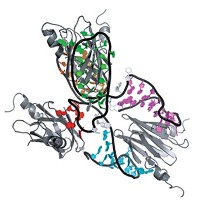Advertisement
Grab your lab coat. Let's get started
Welcome!
Welcome!
Create an account below to get 6 C&EN articles per month, receive newsletters and more - all free.
It seems this is your first time logging in online. Please enter the following information to continue.
As an ACS member you automatically get access to this site. All we need is few more details to create your reading experience.
Not you? Sign in with a different account.
Not you? Sign in with a different account.
ERROR 1
ERROR 1
ERROR 2
ERROR 2
ERROR 2
ERROR 2
ERROR 2
Password and Confirm password must match.
If you have an ACS member number, please enter it here so we can link this account to your membership. (optional)
ERROR 2
ACS values your privacy. By submitting your information, you are gaining access to C&EN and subscribing to our weekly newsletter. We use the information you provide to make your reading experience better, and we will never sell your data to third party members.
Synthesis
Telomerase Pseudoknot Needed For Catalysis
The structural feature is determined to be necessary for the RNA portion of this enzyme to be catalytically active
by Celia Henry Arnaud
May 16, 2011
| A version of this story appeared in
Volume 89, Issue 20
The pseudoknot found in the RNA portion of telomerase—the enzyme that adds guanine-rich segments to the ends of chromosomes—is necessary for the complex to be catalytically active, Xiaowei Zhuang, Mariana Mihalusova, and John Y. Wu of Harvard University report (Proc. Natl. Acad. Sci. USA, DOI: 10.1073/pnas.1017686108). Just as it sounds, a pseudoknot is a structural feature that looks like a knot but isn’t actually one in a topological sense. By attaching two pairs of fluorescence donors and acceptors to different parts of the telomerase RNA, the Harvard team used single-molecule FRET (fluorescence resonance energy transfer) to probe the pseudoknot formation in various circumstances. When the segment making up the pseudoknot is isolated from intact RNA, the pseudoknot folds properly. However, the isolated full-length telomerase RNA misfolds, suggesting that other portions of the RNA get in the way. When the RNA binds the protein subunits, it again adopts the pseudoknot conformation. Some complexes didn’t form the pseudoknot even when bound to the proteins, but only successfully folded complexes were catalytically active.



Join the conversation
Contact the reporter
Submit a Letter to the Editor for publication
Engage with us on Twitter